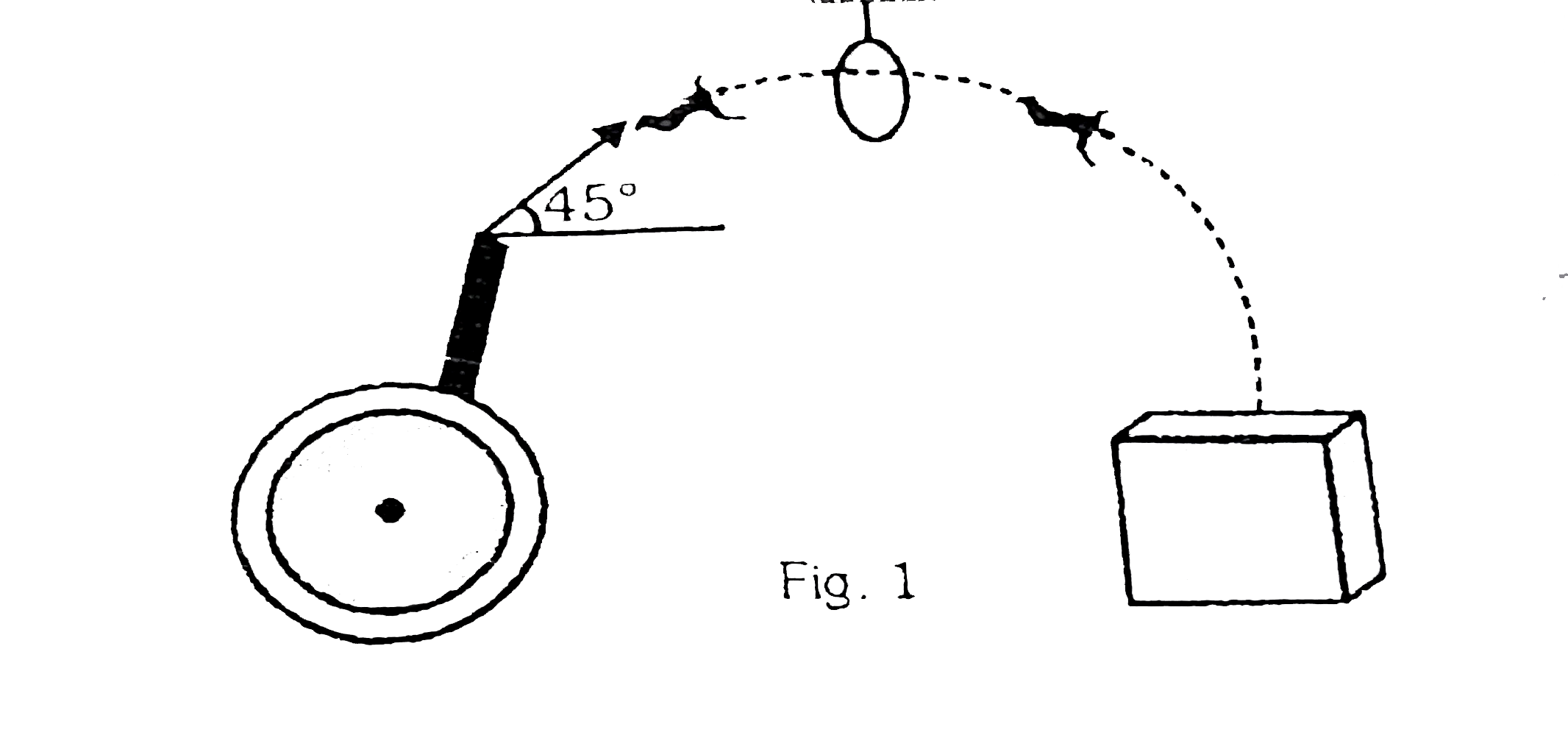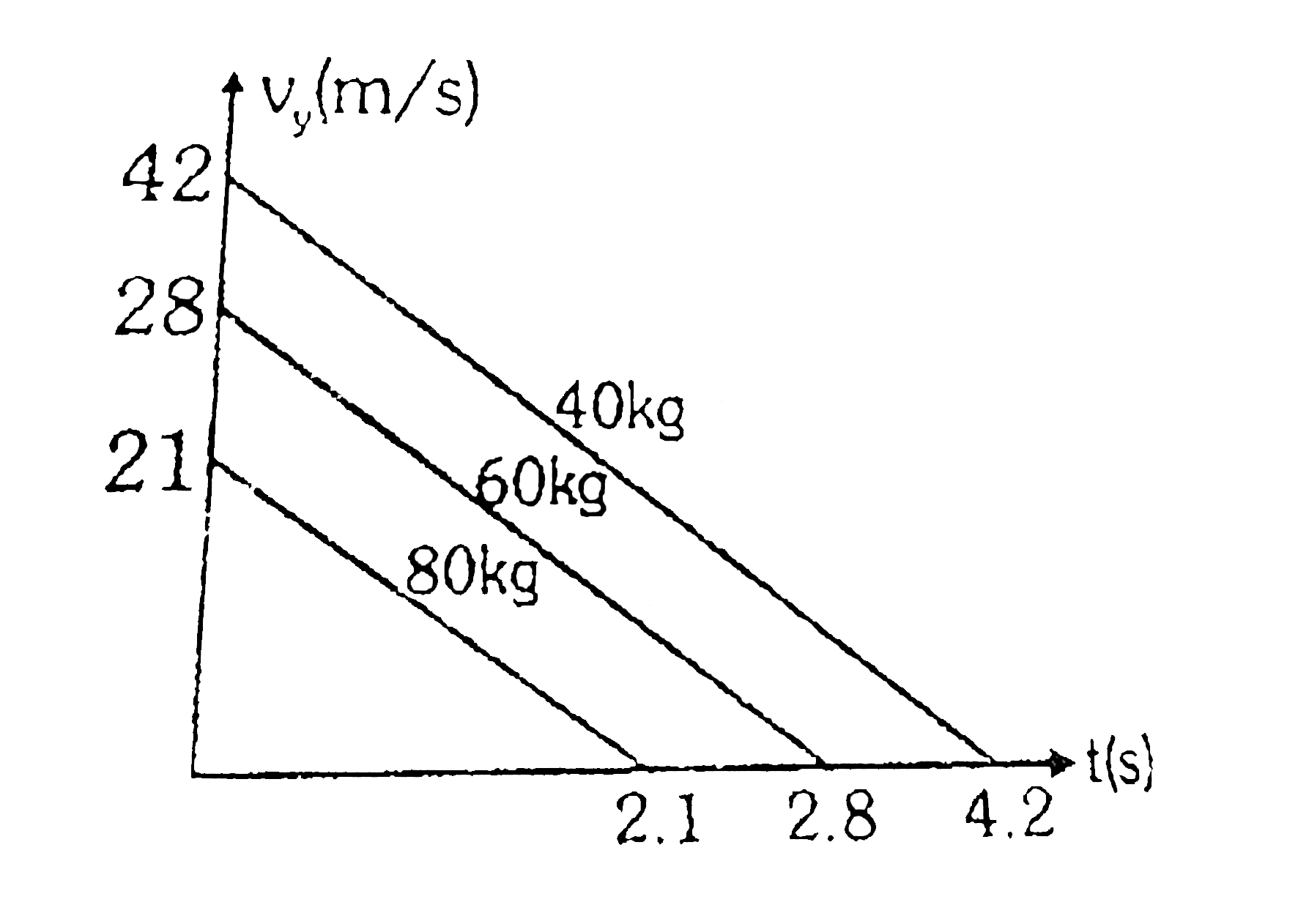When a particle is undergoing motion, the diplacement of the particle has a magnitude that is equal to or smaller than the total distance travelled by the particle. In many cases the displacement of the particle may actually be zero, while the distance travelled by it is non-zero. Both these quantities, however depend on the frame of reference in which motion of the particle is being observed. Consider a particle which is projected in the earth's gravitational field, close to its surface, with a speed of , at an angle of with the horizontal in the eastward direction. Ignore air resistance and assume that the acceleration due to gravity is .
The motion of the particle is observed in two different frames: one in the ground frame (A) and another frame (B), in which the horizontal component of the displacement is always zero. Two observers locates in these frames ill agree on :-Solution in Gujrati
The total distance travelled by the particle
The horizontal range of the particle
The maximum height risen by the particle
None of these
The correct Answer is:C
In ground frame [A] it is simply a projectile motion. But in [B] frame horizontal component of the displacement is zero i.e. in this frame only vertical comp. appear which is responsible for the maximum height.
Topper's Solved these Questions
- BOOK - ALLEN CHAPTER - KINEMATICSEXERCISE - Comprehension#73videos
KINEMATICS
- BOOK - ALLEN CHAPTER - KINEMATICSEXERCISE - EXERCISE-04[A]35videos
KINEMATICS
- BOOK - ALLEN CHAPTER - KINEMATICSEXERCISE - Comprehension#56videos
KINEMATICS
- BOOK - ALLEN CHAPTER - ERROR AND MEASUREMENTEXERCISE - Part-2(Exercise-2)(B)22videos
ERROR AND MEASUREMENT
- BOOK - ALLEN CHAPTER - KINEMATICS (MOTION ALONG A STRAIGHT LINE AND MOTION IN A PLANE)EXERCISE - BEGINNER S BOX-78videos
KINEMATICS (MOTION ALONG A STRAIGHT LINE AND MOTION IN A PLANE)
Similar Questions
A projectile is projected with some initial velocity and some initial angle of projection. A wind is also blowing, due to which constant horizontal retardation a is imparted to the particle in the plane of motion. It is found that, the particle is at same height at two different time t1 & t2 and particle is at same horizontal distance at two different time t3 & t4
Angle of projection of particle is :-07:56View SolutionFig. 2 (NCT).9 show the x−t plot of a particle in one dimensional motion. Three different equal intervals of time are shown. In which interval the average speed is greatest and in which it is the least ? Give th sign of average speed for each interval.
 .07:56View Solution
.07:56View SolutionA circus wishes to develop a new clown act. Fig. (1) shows a diagram of the proposed setup. A clown will be shot out of a cannot with velocity v0 at a trajectory that makes an angle θ=45∘ with the ground. At this angile, the clown will travell a maximum horizontal distance. The cannot will accelerate the clown by applying a constant force of 10,000N over a very short time of 0.24s. The height above the ground at which the clown begins his trajectory is 10m.

A large hoop is to be suspended from the celling by a massless cable at just the right place so that the clown will be able to dive through it when he reaches a maximum height above the ground. After passing through the hoop he will then continue on his trajectory until arriving at the safety net. Fig (2) shows a graph of the vertical component of the clown's velocity as a function of time between the cannon and the hoop. Since the velocity depends on the mass of the particular clown performing the act, the graph shows data for serveral different masses.

If the angle the cannot makes with the horiaontal is increased from 45∘, the hoop will have to be07:56View SolutionA cube has a side of length 1.2×10−2m. Calculate its volume.
07:56View SolutionA football player kicks a ball at an angle of 30∘ with an initial speed of 20 m/s. Assuming that the ball travels in a vertical plane, calculate (a) the time at which the ball reaches the highest point (b) the maximum height reached (c) the horizontal range of the ball (d) the time for which the ball is in the air, (g=10m/s2)
01:51View SolutionWhen a particle is undergoing motion, the diplacement of the particle has a magnitude that is equal to or smaller than the total distance travelled by the particle. In many cases the displacement of the particle may actually be zero, while the distance travelled by it is non-zero. Both these quantities, however depend on the frame of reference in which motion of the particle is being observed. Consider a particle which is projected in the earth's gravitational field, close to its surface, with a speed of 100√2m/s, at an angle of 45∘ with the horizontal in the eastward direction. Ignore air resistance and assume that the acceleration due to gravity is 10m/s2.
The motion of the particle is observed in two different frames: one in the ground frame (A) and another frame (B), in which the horizontal component of the displacement is always zero. Two observers locates in these frames ill agree on :-02:23View SolutionWhen a particle is undergoing motion, the diplacement of the particle has a magnitude that is equal to or smaller than the total distance travelled by the particle. In many cases the displacement of the particle may actually be zero, while the distance travelled by it is non-zero. Both these quantities, however depend on the frame of reference in which motion of the particle is being observed. Consider a particle which is projected in the earth's gravitational field, close to its surface, with a speed of 100sqrt(2) m//s , at an angle of 45^(@) with the horizontal in the eastward direction. Ignore air resistance and assume that the acceleration due to gravity is 10 m//s^(2) . " A third observer (C) close to the surface of the reports that particle is initially travelling at a speed of 100sqrt(2) m//s making on angle of 45^(@) with the horizontal, but its horizontal motion is northward". The third observer is moving in :-
01:31View SolutionWhen a particle is undergoing motion, the diplacement of the particle has a magnitude that is equal to or smaller than the total distance travelled by the particle. In many cases the displacement of the particle may actually be zero, while the distance travelled by it is non-zero. Both these quantities, however depend on the frame of reference in which motion of the particle is being observed. Consider a particle which is projected in the earth's gravitational field, close to its surface, with a speed of 100sqrt(2) m//s , at an angle of 45^(@) with the horizontal in the eastward direction. Ignore air resistance and assume that the acceleration due to gravity is 10 m//s^(2) . There exists a frame (D) in which the distance travelled by the particle is minimum. This minimum distance is equal to :-
02:34View SolutionWhen a particle is undergoing motion, the diplacement of the particle has a magnitude that is equal to or smaller than the total distance travelled by the particle. In many cases the displacement of the particle may actually be zero, while the distance travelled by it is non-zero. Both these quantities, however depend on the frame of reference in which motion of the particle is being observed. Consider a particle which is projected in the earth's gravitational field, close to its surface, with a speed of 100√2m/s, at an angle of 45∘ with the horizontal in the eastward direction. Ignore air resistance and assume that the acceleration due to gravity is 10m/s2.
Consider an observer in frame D (of the previous question), who observes a body of mass 10 kg acelerating in the upward direction at 30m/s2 (w.r.t. himself). The net force acting on this body, as observed from the ground is :-05:18View SolutionSTATEMENT - 1 : Distance travelled by a particle moving rectilinearly may not be equal to magnitude of displacement of the particle. and STATEMENT - 2 : Distance travelled is a scalar but displacement is a vector.
02:58View SolutionThe equation for the motion of a particle is v = at . The distance travelled by the particle in the first 4 second is :
01:57View SolutionIf distance travelled by particle is zero then its displacement is …... .
01:36View Solutionयदि किसी कण का विस्थापन शून्य है तो तय की गयी दूरी :
01:18View SolutionSTATEMENT - 1 : Distance travelled by a particle moving rectilinearly may not be equal to magnitude of displacement of the particle. and STATEMENT - 2 : Distance travelled is a scalar but displacement is a vector.
01:22View SolutionWhen a particle is undergoing motion, the diplacement of the particle has a magnitude that is equal to or smaller than the total distance travelled by the particle. In many cases the displacement of the particle may actually be zero, while the distance travelled by it is non-zero. Both these quantities, however depend on the frame of reference in which motion of the particle is being observed. Consider a particle which is projected in the earth's gravitational field, close to its surface, with a speed of 100sqrt(2) m//s , at an angle of 45^(@) with the horizontal in the eastward direction. Ignore air resistance and assume that the acceleration due to gravity is 10 m//s^(2) . " A third observer (C) close to the surface of the reports that particle is initially travelling at a speed of 100sqrt(2) m//s making on angle of 45^(@) with the horizontal, but its horizontal motion is northward". The third observer is moving in :-
06:50View Solution
